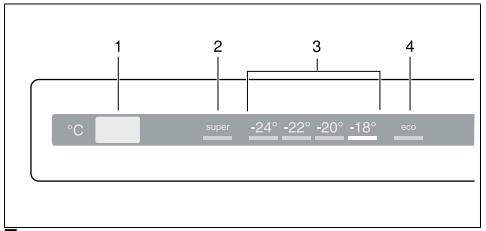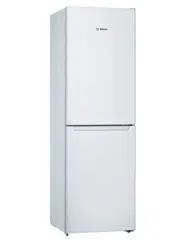Documents: Go to download!
- Owner's manual - (English, Czech, Russian, Slovenian, Turkish)
- Scope of delivery
- Installation location
- Observe ambient temperature and ventilation
- Connecting the appliance
- Getting to know your appliance
- Switching on the appliance
- Setting the temperature
- eco
- Alarm functions
- Usable capacity
- Refrigerator compartment
- Freezer compartment
- Freezing capacity
- Freezing and storing food
- Freezing fresh food
- Super freezing
- Thawing frozen food
- Interior fittings
- Sticker “OK”
- Switching off and disconnecting the appliance
- Cleaning the appliance
- Light (LED)
- Tips for saving energy
- Operating noises
- Eliminating minor faults yourself
Table of contents
Scope of delivery
After unpacking all parts, check for any damage in transit.
If you have any complaints, please contact the dealer from whom you purchased the appliance or our customer service.
The delivery consists of the following parts:
- Free-standing appliance
- Interior fittings (depending on model)
- Bag containing installation materials
- Operating instructions
- Installation manual
- Customer service booklet
- Warranty enclosure
- Information on the energy consumption and noises
Installation location
A dry, well ventilated room is suitable as an installation location. The installation location should not be exposed to direct sunlight and not placed near a heat source, e.g. a cooker, radiator, etc. If installation next to a heat source is unavoidable, use a suitable insulating plate or observe the following minimum distances from the heat source:
- 3 cm to electric or gas cookers.
- 30 cm to an oil or coal-fired cooker.
The floor of the installation location must not give way; if required, reinforce floor. If the floor is uneven, compensate with supports.
Distance from wall
Fig  : A gap is not required between the appliance and side wall. The containers and shelves are still fully extendable
: A gap is not required between the appliance and side wall. The containers and shelves are still fully extendable
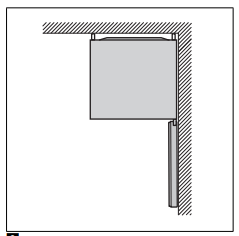
Observe ambient temperature and ventilation
Ambient temperature
The appliance is designed for a specific climate class. Depending on the climate class, the appliance can be operated at the following temperatures.
The climate class can be found on the rating plate. Fig. 

| Climate class | Permitted ambient temperature |
| SN | +10 °C to 32 °C |
| N | +16 °C to 32 °C |
| ST | +16 °C to 38 °C |
| T | +16 °C to 43 °C |
Note: The appliance is fully functional within the room temperature limits of the indicated climatic class. If an appliance of climatic class SN is operated at colder room temperatures, the appliance will not be damaged up to a temperature of +5 °C.
Ventilation
Fig. : The air on the rear panel and on the side panels of the appliance heats up. Conduction of the heated air must not be obstructed. Otherwise, the refrigerating unit must work harder. This increases power consumption. Therefore: Never cover or block the ventilation openings!
: The air on the rear panel and on the side panels of the appliance heats up. Conduction of the heated air must not be obstructed. Otherwise, the refrigerating unit must work harder. This increases power consumption. Therefore: Never cover or block the ventilation openings!
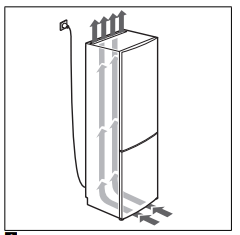
Connecting the appliance
After installing the appliance, wait at least 1 hour until the appliance is switched on. During transportation the oil in the compressor may have flowed into the refrigeration system.
Before switching on the appliance for the first time, clean the interior of the appliance (see chapter “Cleaning the appliance”).
Electrical connection
The socket must be near the appliance and also freely accessible following installation of the appliance.
Warning: Risk of electric shock!
If the length of the mains cable is inadequate, never use multiple sockets or extension leads. Instead, please contact Customer Service for alternatives.
The appliance complies with protection class I. Connect the appliance to 220– 240 V/50 Hz alternating current via a correctly installed socket with protective conductor. The socket must be protected by a 10 A to 16 A fuse.
For appliances operated in non European countries, check whether the indicated voltage and current type match the values of your electricity supply. This information can be found on the rating plate, Fig 

Warning: Never connect the appliance to electronic energy saver plugs.
Our appliances can be used with mains and sine-controlled inverters. Mains controlled inverters are used for photovoltaic systems which are connected directly to the national grid. Sine-controlled inverters must be used for isolated applications (e.g. on ships or in mountain lodges) which are not connected directly to the national grid.
Getting to know your appliance

Please fold out the illustrated last page. These operating instructions refer to several models.
The features of the models may vary.
The diagrams may differ. Fig.

* Not all models.
A: Refrigerator compartment
B: Freezer compartment
1–4. Controls
5. Shelf for small bottles
6. Shelf for large bottles
7. Light
8. Temperature controller
9. Vegetable container
10*. Freezer tray
11. Frozen food container (small)
Controls
Fig. 
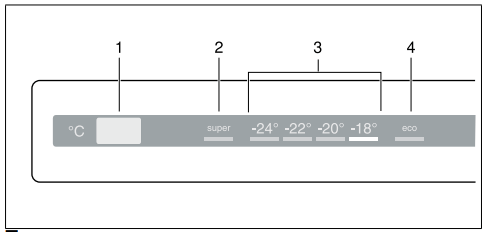
- Temperature selection button The required temperature is set with this button.
- “super” display (freezer compartment) Illuminates when super freezing is on.
- Temperature display freezer compartment The numbers correspond to the set freezer compartment temperatures in °C.
- Eco mode indicator This lights up when the eco mode is switched on.
Switching on the appliance
Fig. 

- Insert the plug in the socket.
- A warning signal sounds. The temperature display 3 flashes.
- Press the temperature setting button
1. The warning signal switches off.
When the freezer compartment has reached the set temperature, the temperature display 3 is lit.
The factory recommends the following settings:
- Refrigerator compartment: medium setting
- Freezer compartment: -18°C
Store delicate foods in the refrigerator compartment.
Operating tips
- When the appliance has been switched on, it may take several hours until the set temperatures have been reached.
- The fully automatic No Frost system ensures that the freezer compartment remains free of ice. Defrosting is no longer required.
- The sides of the housing are sometimes heated slightly. This prevents condensation in the area of the door seal.
- If the freezer compartment door cannot be immediately re-opened after it has been closed, wait until the resulting low pressure has equalised
Setting the temperature
Refrigerator compartment
Turn temperature controller, Fig. /8, to the required setting.
/8, to the required setting.

We recommend the setting in line with the marking.
Changing the setting clockwise will lower temperatures in the refrigerator compartment.
At a room temperature below 16°C, slightly increase the temperature setting in the appliance. At a room temperature above 32°C, slightly reduce the temperature setting in the appliance.
Select a very cold setting only temporarily if:
- door is opened frequently,
- large quantities of food are placed in the refrigerator compartment.
Freezer compartment
The temperature can be set from -18°C to -24°C.
Keep pressing temperature setting button 1 until the required freezer compartment temperature is set.
The last set value is saved. The set temperature is indicated on temperature display 3.
eco
The “eco” function switches the appliance to energy-saving mode.
The appliance automatically sets the following temperatures:
- Freezer compartment: -16°C
Switching on eco
Keep pressing the temperature setting button 1 until the eco indicator is highlighted.
Alarm functions
Fig  .
.

Door alarm
The door alarm (continuous sound) switches on if the appliance door is open for longer than one minute. Close the door to switch off the warning signal.
Temperature alarm
The temperature alarm switches on if the freezer compartment is too warm and the frozen food is at risk of thawing.
Temperature display, Fig. /3, is flashing.
/3, is flashing.

The alarm may switch on without any risk to the frozen food:
- when the appliance is switched on,
- when large quantities of fresh food are placed in the appliance,
- if the freezer compartment door is open too long.
Note:
Do not refreeze thawing or thawed food. Only ready meals (boiled or fried) may be refrozen.
No longer store the frozen produce for the max. storage period.
Switching off the alarm
Fig.  : Press the temperature setting button 1 to switch off the warning signal.
: Press the temperature setting button 1 to switch off the warning signal.

Usable capacity
Information on the usable capacity can be found inside your appliance on the rating plate. Fig. 

Fully utilising the freezer volume
To place the maximum amount of frozen food in the freezer compartment, you can remove the containers. You can then stack the food directly on the shelf and on the floor of the freezer compartment.
Note:
Avoid contact between food and rear panel. Otherwise the air circulation will be impaired.
Food or packaging could freeze to the rear panel.
Removing the fittings
Pull out the frozen food container all the way, lift at the front and remove. Fig. '
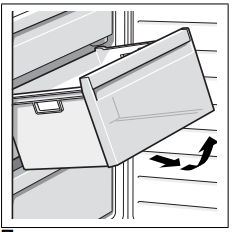
Refrigerator compartment
The refrigerator compartment is the ideal storage location for meat, sausage, fish, dairy products, eggs, ready meals and pastries.
Storing food
- Store fresh, undamaged food. The quality and freshness will then be retained for longer.
- In the case of ready-made products and bottled goods, observe the best before date or use-by date specified by the manufacturer.
- To retain aroma, colour and freshness, pack or cover food well before placing in the appliance. This will prevent the transfer of flavours and the discolouration of plastic parts in the refrigerator compartment.
- Allow warm food and drinks to cool down before placing in the appliance
Note: Do not block air outlet openings with food, otherwise the air circulation will be impaired. Food which is stored directly in front of the air outlet openings may be frozen by the cold air flowing out.
Note the chill zones in the refrigerator compartment
The air circulation in the refrigerator compartment creates different chill zones:
- Coldest zone is in the upper area of the refrigerator compartment.
Note: Store perishable food (e.g. fish, sausage, meat) in the coldest zone.
- Warmest zone is at the very bottom of the door and in the vegetable container.
Note: Store e.g. hard cheese and butter in the warmest zone. Cheese can then continue to release its flavour and the butter will still be easy to spread.
Vegetable container
Fig.  /9
/9
A high air humidity keeps leafy vegetables fresh for longer. Vegetables and fruit should be stored at a slightly lower air humidity.
The air humidity in the vegetable drawer depends on the amount of stored food.
Note: If the air humidity is too high, drips may form and cause decay.
Freezer compartment
Use the freezer compartment
- To store deep-frozen food.
- To make ice cubes.
- To freeze food.
Note: Ensure that the freezer compartment door has been closed properly. If the door is open, the frozen food will thaw. The freezer compartment will become covered in thick ice. Also: waste of energy due to high power consumption!
Freezing capacity
Information on the freezing capacity can be found on the rating plate. Fig.
Prerequisites for freezing capacity
- Switch on fast freezing 24 hours before placing fresh products in the compartment (see chapter “Fast freezing”).
- Preferably freeze large quantities of food in the bottom compartment. This is where food freezes particularly quickly and therefore also gently.
Freezing and storing food
Purchasing frozen food
- Packaging must not be damaged.
- Use by the “use by” date.
- Temperature in the supermarket freezer must be -18 °C or lower.
- If possible, transport deep-frozen food in an insulated bag and place quickly in the freezer compartment.
When loading products, please note:
- Freeze larger quantities of food preferably in the bottom frozen food container. This is where food freezes particularly quickly and therefore also gently.
- Distribute the food over the whole area of the compartments or the frozen food containers.
Note: Food which is already frozen must not come into contact with the food which is to be frozen. If necessary, re-stack frozen food in the frozen food containers.
- To ensure air circulation in the appliance, push the frozen food container all the way in.
Storing frozen food
Insert frozen food container all the way to ensure unrestricted air circulation.
Freezing fresh food
Freeze fresh and undamaged food only.
To retain the best possible nutritional value, flavour and colour, vegetables should be blanched before freezing. Aubergines, peppers, zucchini and asparagus do not require blanching.
Literature on freezing and blanching can be found in bookshops.
Note: Keep food which is to be frozen away from food which is already frozen.
- The following foods are suitable for freezing:
Cakes and pastries, fish and seafood, meat, game, poultry, vegetables, fruit, herbs, eggs without shells, dairy products such as cheese, butter and quark, ready meals and leftovers such as soups, stews, cooked meat and fish, potato dishes, soufflés and desserts.
- The following foods are not suitable for freezing:
Types of vegetables, which are usually consumed raw, such as lettuce or radishes, eggs in shells, grapes, whole apples, pears and peaches, hard-boiled eggs, yoghurt, soured milk, sour cream, crème fraîche and mayonnaise.
Packing frozen food
To prevent food from losing its flavour or drying out, place in airtight containers.
- Place food in packaging.
- Remove air.
- Seal the wrapping.
- Label packaging with contents and date of freezing.
Suitable packaging:
Cling wrap, tubular film made of polyethylene, aluminium foil, freezer containers.
These products are available from specialist outlets.
Unsuitable packaging:
Wrapping paper, greaseproof paper, cellophane, bin liners and used shopping bags.
Items suitable for sealing packaged food:
Rubber bands, plastic clips, string, coldresistant adhesive tape, etc.
Bags and tubular film made of polyethylene (PE) can be sealed with a film heat sealer.
Shelf life of frozen food
Storage duration depends on the type of food.
At a temperature of -18 °C:
- Fish, sausage, ready meals and cakes and pastries:
up to 6 months
- Cheese, poultry and meat:
up to 8 months
- Vegetables and fruit:
up to 12 months
Super freezing
Food should be frozen solid as quickly as possible in order to retain vitamins, nutritional value, appearance and flavour.
The appliance runs constantly when super freezing has been switched on. The freezer compartment temperatures are much lower than in normal operation.
Several hours before placing fresh food in the freezer compartment, switch on super freezing to prevent an unwanted temperature rise.
If the freezing capacity according to the rating plate is to be used, switch on super freezing 24 hours before the fresh products are placed in the freezer compartment.
Smaller quantities of food (up to 2 kg) can be frozen without “super freezing”.
Note: When super freezing is switched on, increased operating noises may occur.
Switching on and off
Keep pressing the temperature selection button 1 until the Super display 2 is lit.
Super freezing automatically switches off after approx. 2½ days.
Thawing frozen food
Depending on the type and application, select one of the following options:
- at room temperature
- in the refrigerator
- in an electric oven, with/without fan assisted hot-air
- in the microwave
Caution
Do not refreeze thawing or thawed food. Only ready meals (boiled or fried) may be refrozen.
No longer store the frozen produce for the max. storage period.
Interior fittings
You can reposition the shelves inside the appliance and the door shelves as required:
- Pull shelf forwards, lower and swing out to the side. Fig.

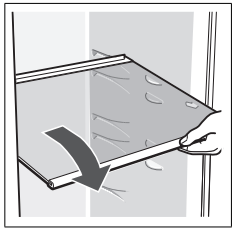
- Raise the door shelf and remove. Fig.


Special features
(not all models)
Butter and cheese compartment
To open the butter compartment, gently press in the middle of the butter compartment flap.
To clean the compartment, lift it at the bottom and take out.
Ice pack
The ice pack can be removed to cool food temporarily, e.g. in a cold bag.
If a power failure or malfunction occurs, the ice pack can be used to slow down the thawing process.
Ice cube tray
Fig. 
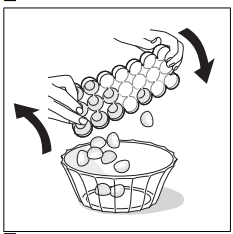
- Fill the ice cube tray ¾ full of drinking water and place in the freezer compartment.
- If the ice tray is stuck to the freezer compartment, loosen with a blunt implement only (spoon-handle).
- To loosen the ice cubes, twist the ice tray slightly or hold briefly under flowing water.
Breakfast set
Fig. 
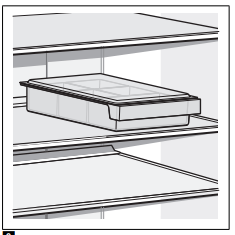
The containers for the breakfast set can be taken out and filled individually.
Bottle shelf
Fig. 
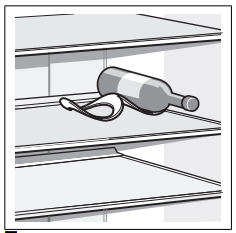
Bottles can be stored securely on the bottle shelf.
Sticker “OK”
(not all models)
The sticker “OK” lets you check whether the refrigerator compartment achieves the safe temperature ranges of +4 °C or colder recommended for food. If the sticker does not indicate “OK”, gradually reduce the temperature.
Note: When the appliance is switched on, it may take up to 12 hours until the set temperature is reached.

Correct setting
Switching off and disconnecting the appliance
Switching off the appliance
Pull out mains plug or switch off fuse. Refrigerating unit switches off.
Disconnecting the appliance
If you do not use the appliance for a prolonged period:
- Pull out the mains plug or switch off the fuse.
- Clean the appliance.
- Leave appliance doors open.
Cleaning the appliance
Caution
- Do not use abrasive, chloride or acidic cleaning agents or solvents.
- Do not use scouring or abrasive sponges.
The metallic surfaces could corrode.
- Never clean shelves and containers in the dishwasher.
The parts may become deformed!
The cleaning water must not get into the following areas:
- Controls
- Illumination
- Ventilation openings
- Openings in the separating plate
Proceed as follows:
1. Pull out the mains plug or switch off the fuse.
2. Take out the frozen food and store in a cool location. Place ice pack (if available) on the food.
3. The rinsing water must not drip into the controls, lighting, ventilation openings or the openings in the partition!
Clean the appliance with a soft cloth, lukewarm water and a little pH-neutral washing-up liquid.
4. Wipe the door seal with clear water only and then wipe dry thoroughly.
5. After cleaning reconnect the appliance.
6. Put the frozen food back into the appliance.
Interior fittings
All variable parts of the appliance can be taken out for cleaning.
Take out shelves in the door
Fig. 
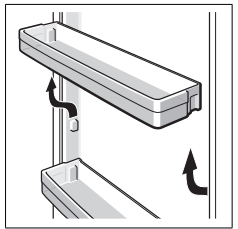
Lift shelves upwards and take out.
Take out glass shelves
Pull the glass shelves forwards and take out.
Removing the container
Fig. 
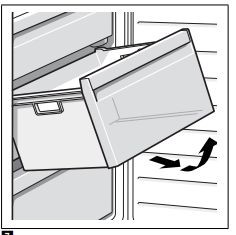
Pull out the container all the way, lift at the front and remove.
Taking out the frozen food container
Fig. 

Pull out the frozen food container all the way, lift at the front and remove.
Light (LED)
Your appliance features a maintenance free LED light.
These lights may be repaired by customer service or authorised technicians only
Tips for saving energy
- Install the appliance in a dry, well ventilated room! The appliance should not be installed in direct sunlight or near a heat source (e.g. radiator, cooker).
If required, use an insulating plate.
- Allow warm food and drinks to cool down before placing in the appliance.
- Thaw frozen food in the refrigerator compartment and use the low temperature of the frozen food to cool refrigerated food.
- Open the appliance as briefly as possible.
- To achieve the lowest energy consumption, leave a small wall gap at the side.
- The arrangement of the fittings does not affect the energy rating of the appliance.
Operating noises
Quite normal noises
Note: When super freezing is switched on, increased operating noises may occur.
Droning
Motors are running (e.g. refrigerating units, fan).
Bubbling, humming or gurgling noises
Refrigerant is flowing through the tubing.
Clicking
Motor, switches or solenoid valves are switching on/off.
Cracking
Automatic defrosting is running.
Preventing noises
The appliance is not level
Please align the appliance with a spirit level. Use the height-adjustable feet or place packing underneath them.
The appliance is not free-standing
Please move the appliance away from adjacent units or appliances.
Containers or storage areas wobble or stick
Please check the removable parts and re-insert them correctly if required.
Bottles or receptacles are touching each other
Move the bottles or receptacles slightly away from each other.
Eliminating minor faults yourself
Before you call customer service:
Please check whether you can eliminate the fault yourself based on the following information.
Customer service will charge you for advice – even if the appliance is still under guarantee!
| Fault | Possible cause | Remedial action |
| Temperature differs greatly from the set value. |
In some cases it is adequate to switch off the appliance for 5 minutes. If the temperature is too high wait a few hours and check whether the temperature has approached the set value. If the temperature is too low check the temperature again the next day. |
|
|
A warning signal sounds. Temperature display flashes. Fig. |
Fault - the freezer section is too warm! Frozen food is at risk. Appliance is open. |
To switch off the warning signal, press temperature setting button Fig. Close the appliance. |
| Ventilation openings are covered up | Ensure that there is adequate ventilation. | |
| Too much food was placed in the freezer at once. | Do not exceed the freezing capacity. | |
| When the fault has been eliminated, the temperature display stops flashing. | ||
| The temperature in the freezer section is too warm. | Appliance opened frequently. | Do not open the appliance unnecessarily. |
| The ventilation openings have been covered. | Remove obstructions. | |
| Large quantities of fresh food are being frozen. | Do not exceed the freezing capacity. | |
| The side panels of the appliance are warm. | Pipes run into the side panels which heat during the cooling process. |
That is normal behaviour for the appliance and not a fault. Furniture touching the appliance will not be damaged by the heat. |
| The light does not function. | The LED light is defective. | See chapter “Light (LED)” section. |
|
Appliance was open too long. Light is switched off after approx. 10 min. |
When the appliance is closed and opened, the light is on again. | |
| Controls have reduced luminosity | When the appliance is not used for some time, the display on the fascia switches to energy saving mode. | As soon as the appliance is again used, e.g. the door is opened, the display switches back to normal illumination. |
| Displays do not illuminate | Power failure; the fuse has been switched off; the mains plug has not been inserted properly. | Connect mains plug. Check whether the power is on, check the fuses. |
| Appliance is not cooling, temperature display and light are lit. | Showroom mode is switched on. |
Hold down temperature selection button fig.
After a short time check whether your appliance is cooling. |
| Freezer compartment door was open for a long time; temperature is no longer reached. | The evaporator (refrigeration generator) in the NoFrost system is covered in thick ice and can no longer be defrosted fully automatically |
To defrost the evaporator, remove the frozen food with the compartments, insulate well and store in a cool location. Switch off the appliance and move it away from the wall. Leave the appliance door open. After approx. 20 min. the condensation begins to run into the evaporation pan, at the rear of the appliance. To prevent the evaporation pan from overflowing in this case, mop up the condensation with a sponge. The evaporator is defrosted when the water stops running into the evaporation pan. Clean the interior. Switch the appliance back on again |
See other models: KGN36NW30G KGV33VL31G KGN34NL3AG KGV36VL32G KGV39VW32G
 /3
/3 /1 for 10 seconds until an acknowledgement signal sounds.
/1 for 10 seconds until an acknowledgement signal sounds.